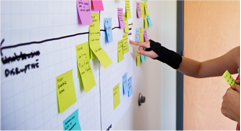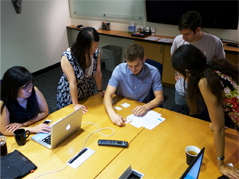

In mid May 2012, we kicked off the design phase of our project. We picked up where we had left of at the end of research with ideation. We facilitated a brainstorming session with M*Modal and refocused our visioning around supporting compliance in narrative documentation. The focus throughout design was on validating our ideas early and often by exposing them to users. We engaged in rapid, iterative design. With each round of testing we refined our ideas before putting them back in the hands of users for evaluation. In total, our designs were tested with 39 participants as we worked towards a solution.




Ideation began with brainstorming. We held two brainstorming sessions. One within the team, and one which we facilitated with stakeholders at M*Modal. Between these sessions we generated a few hundred ideas. These ideas were plotted on a quad to evaluate their relative potential in assisting physicians with information capture.
Our strongest brainstorm ideas were combined into concept storyboards. The team produced twelve storyboards which were evaluated through a process called speed dating. In this low-cost evaluation method, we were able to get quick feedback from a large number of participants in a short amount of time. By the end of this process it was clear which ideas were worth pursuing as prototypes.



Drawing on the concepts that had performed well in speed dating, we developed three low-fidelity, paper prototypes. These paper prototypes were quick to put together and allowed us to uncover many of the issues with the designs. We worked through these paper prototypes both with a physician, and with staff at M*Modal.
Based on feedback we recieved on the paper prototypes, we moved quickly into medium-fidelity with two parallel design concepts. When compared to the paper prototypes, these digital prototypes gave us more meaningful insight into the quality of the interactions we had provided. These prototypes were evaluated in an analogous setting, rather than with physicians, so that we could more quickly evaluate the interactions with a large group of participants.
The analogous testing proved extremely valuable. Based on the results, we were able to narrow our focus to a single design concept. We implemented this concept at a medium-fidelity, translating it back to the medical domain to ensure that the results were consistent with our findings from the analogous tests. What followed was a series of rapid testing rounds. After each round, our prototype was refined to reflect our findings. Gradually the design evolved from medium to high fidelity, exhibiting near full functionality, and a mature design language. The final prototype formed the basis for our final design recommendations.